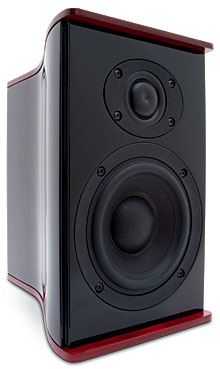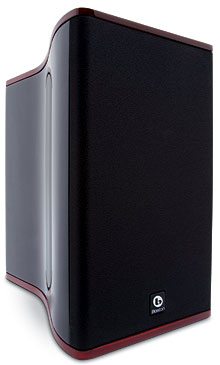Boston Acoustics VS 240 Speaker System
 Price: $3,695 At A Glance: Distinctive bell-shaped footprint offers unique look • Gleaming enclosures with top-drawer fit and finish • Great midrange and deep, confident bass
Price: $3,695 At A Glance: Distinctive bell-shaped footprint offers unique look • Gleaming enclosures with top-drawer fit and finish • Great midrange and deep, confident bass
Ringin’ the Bell Curve
The Vision and Sound speakers from Boston Acoustics were in my listening room when a friend visited. He works for a competing manufacturer and has spent time on the retail floor. He said, candidly and emphatically, “Boston Acoustics has never made a bad speaker.”

Nonetheless, this is a transitional time for Boston Acoustics. Based in Peabody, Massachusetts, the once independent brand joined the D&M family of brands in 2005. That’s not a bad thing; the move placed Boston in the company of Snell and McIntosh, not to mention Denon and Marantz.
The old Boston Acoustics, founded in 1979, sold conventional floorstanding and bookshelf speakers—in other words, the kind of speakers that appeal to an aging demographic that appreciates good sound. Until now, the new Boston Acoustics has concentrated on products intended to capture younger consumers, notably the sporty HS Series with its curved molded-plastic enclosures. The current Boston family also includes sat/sub sets and soundbars, along with computer, on-wall, in-wall, in-ceiling, in-cabinet, and outdoor speakers.
Vision and Sound represents the re-emergence of Boston Acoustics with a product that aims to unite the generations. Old-fashioned audiophiles will respond to the sound. And younger listeners who have an aversion to old-fashioned speakers will respond to the look and feel—as well as the sound.
 Like Ringing a Bell
Like Ringing a Bell
I reviewed a matched six-piece set of the VS 240, a two-way 4.5-inch monitor, and the VPS 210 sub. I elected not to use the matching VS 224LCR in the center because I always advise using three identical speakers across the front. And from time to time, I take my own advice. The Vision and Sound family also includes the VS 336, a three-way triple 6.5-inch floorstander; the VS 260, a two-way 6.5-inch monitor; and the VS 325c, a three-way dual 5.25-inch center.
The Vision and Sounds are drop-dead gorgeous speakers with virtually unscratchable lacquer finishes. Viewed from above, the VS 240 has a bell shape with wave-like curves. This isn’t the first time a speaker has used curves to defeat acoustically undesirable internal standing waves—but it has rarely been done with such a distinctive and idiosyncratic beauty. Boston Acoustics produces the curves by pressing and curing the panels. The front, back, and sides are 0.6 inches thick. But Boston Acoustics claims the pressing process makes them stiffer than they’d be at 0.8 inches thick. They’re also strengthened by internal bracing.
Unless you opt for the all-black model, the top and bottom end caps come in a variety of amazing wood veneers. My review samples’ Dark Cherry finish may be the most sensuous variation. The grilles attach by clipping at the sides, with no pins, which eliminates any possibility of loose fit or buzzing.
The VS 240’s back has a slot-shaped port and a very sturdy set of metal hex-nut binding posts. There are two threaded inserts but no keyhole mount. Presumably, Boston wants any wall mount you attempt to have a tight fit. Because the wave-like curve continues on the bottom surface, the speaker rests partly on its front end and partly on the rubber foot of a thick right-angled metal piece that attaches to the back. Everything about the speaker’s fit n’ finish makes you say wow.
 A fabric-dome tweeter with a laminated damping layer is on the front of the speaker. The slight depression in the middle makes it look like a toddler’s finger has punched in the tweeter. But appearances are deceiving. The center of the driver is actually terminated to a brass plug underneath. I’ll let Boston’s Michael Chamness describe the benefits of what the company calls the Coupled Dual Concentric Diaphragm:
A fabric-dome tweeter with a laminated damping layer is on the front of the speaker. The slight depression in the middle makes it look like a toddler’s finger has punched in the tweeter. But appearances are deceiving. The center of the driver is actually terminated to a brass plug underneath. I’ll let Boston’s Michael Chamness describe the benefits of what the company calls the Coupled Dual Concentric Diaphragm:
“The idea is to keep the center of the dome from acting out of phase with the outside edge, which is what happens with a typical dome tweeter above some high frequency. Pinning the center prevents this. But the resulting ring-like radiator has poor off-axis response and lower sensitivity. In our tweeter, the diaphragm area outside the coil and the area inside the coil act together (Dual Concentric) in phase to give extended response, higher sensitivity (more area), and good off-axis response.”
The woofers in both the VS 240 speaker and VPS 210 subwoofer are made of Organic Composite Cone Material (OCCM), in Boston-speak. Specifically, it’s kapuk, an Indonesian wood fiber that reportedly provides better damping than the conventional fibers used in paper cones.
- Log in or register to post comments




































































